
E-mail: font@focusonnature.com
Phone: Toll-free in USA 1-888-721-3555
or 302/529-1876
 |
PO Box 9021,
Wilmington, DE 19809, USA E-mail: font@focusonnature.com Phone: Toll-free in USA 1-888-721-3555 or 302/529-1876 |
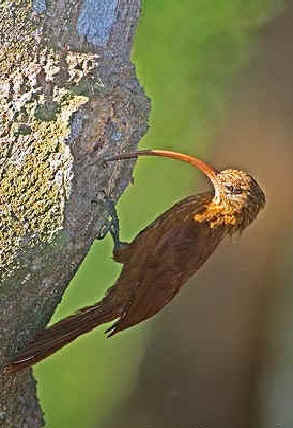 Brazil
Birds
Brazil
Birds
Antshrikes to Woodcreepers
Noting those found during
Focus On Nature Tours
in Brazil with an (*)
from 1992 thru 2015
during the months of February,
March, May, July, August,
September, October, November
Part 3 of a List of Brazil Birds
with
some photos
compiled by Armas Hill
Upper right
photo: RED-BILLED SCYTHEBILL
(Photographed by Andy Smith during a FONT tour in Brazil)
Links to Bird Groupings in this part of this list:
Antbirds Gnateaters Tapaculos Ant-thrushes & Antpittas Miners & Cinclodes
Horneros
Spinetails & allies Foliage-gleaners
Woodcreepers
Links to Other Parts of
this List of Brazil Birds:
Part #1: Tinamous to Doves Part #2: Macaws to Flycatchers Part #4: Vireos to Grosbeaks
Lists of Brazilian Birds in:
The Amazon Basin (in Brazil, Ecuador, Venezuela)
Mato Grosso & Mato Grosso do Sul (including the Pantanal)
Minas Gerais, in interior south-central Brazil
Rio Grande do Sul, in southernmost Brazil
Southeast
Brazil (the states of Rio de Janeiro & Sao Paulo)
and a special list of:
Rare
& Threatened Birds of Brazil (with some photos)
There have been 50 FONT
birding tours in Brazil.
1,065 species of birds have
cumulatively been seen during FONT Brazilian tours.
Generally the taxonomy in this list conforms with
that in the Howard & Moore
"Complete Checklist of the Birds of the World", 3rd edition, edited by
Edward Dickinson. More recently, some nomenclature here is from
"Birds of the World - Recommended English Names" by Frank Gill &
Minturn Wright (published in 2006).
Codes:
(BRi): introduced species
in Brazil
(BRe): endemic to Brazil
(BRqe): quasi (or nearly) endemic to Brazil
(r/BR): rare in Brazil
(t): a globally threatened or
rare species, designated by Birdlife International
(t1): critical (t2):
endangered (t3): vulnerable
(nt): a near-threatened
species globally
In the list that
follows, relating to sightings during FONT tours, the Brazilian region or state & the months
are noted.
AF: the Alta Floresta and Rio Cristalino
areas (mostly Amazonian)
AM: Amazonas state, mostly in the area of Manaus
BR: Brasilia
ES: Espiritu Santo state
IG: the area of Iguacu Falls (in Parana
state)
MN: Minas Gerais state
MS: Mato Grosso do Sul state
MT: Mato Grosso state (excluding Alta Floresta/Rio
Cristalino)
(including the
Pantanal, Chapada dos Guimaraes, Serra das Araras,
and Jardim da Amazonia,
in
central MT near the Rio Claro)
NE:
Northeast
Brazil
SE: Southeast Brazil
(particularly places in the states
of Rio de Janeiro & Sao Paulo,
including the
areas of Itatiaia Natl Park, Ubatuba,
Angra dos Reis, and Cubatao along the coast)
RS: state of Rio Grande do Sul in far-southern Brazil
x after the 2-letter code indicates out-of-range (probable escape)
(ph): SPECIES WITH A PHOTOGRAPH either in this list or elsewhere in the FONT web-site
Other Links:
Upcoming
FONT Birding & Nature Tours in Brazil
Upcoming FONT Tours
Elsewhere
FONT Past Tour Highlights Photo Galleries &
Narratives from Past FONT Tours
Mammals & Other Wildlife during FONT Brazil Tours (with some photos)
Butterflies of Brazil & nearby Argentina, including at Iguazu Falls (with some photos)
Amphibians & Reptiles of Brazil (with some photos)
Tropical Plants, including some in South America
Directory of Photographs in this Web-Site
Bird-List:
CYMBILAIMUS:
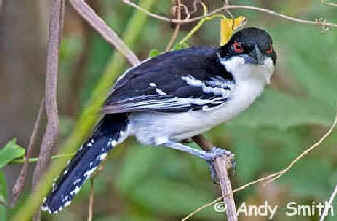
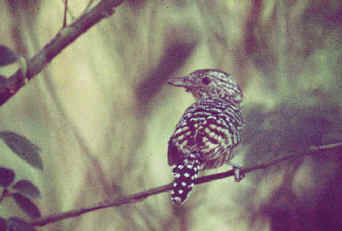
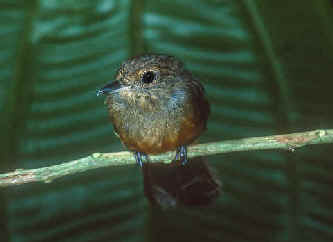
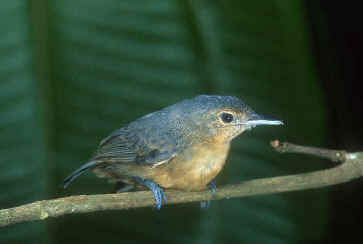
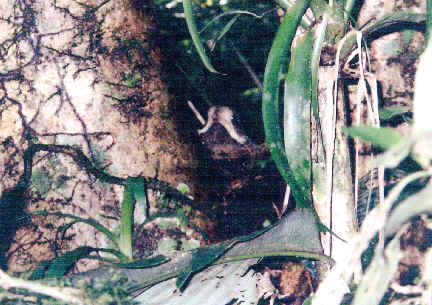
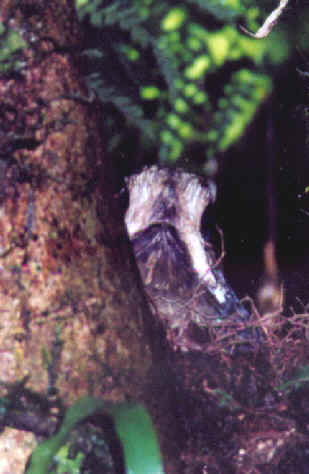
Campo Miner
(nt) (*) ______ MN:oct mt
Geobates
(formerly Geositta) poeciloptera
(monotypic)
GEOSITTA
Common
Miner (ph) (*) ______ RS:oct (in far-southern Brazil)
Geositta cunicularia
Outside Brazil, the Common Miner has been
found during FONT tours in Argentina, Chile.
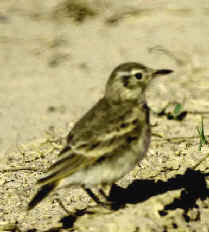
A Common Miner photographed
during the FONT Brazil Tour
in Rio Grande do Sul in October 2009
There are 9 subspecies of the Common Miner.
This is the nominate, Geositta c. cunicularia.
CINCLODES
Bar-winged
Cinclodes ______ (seasonally in far-southern Brazil)
Cinclodes fuscus
Outside Brazil, the Bar-winged Cinclodes has been found during FONT
tours in Argentina, Chile, Venezuela.
Long-tailed
Cinclodes (nt) (BRe) (ph) (*) ______ RS:oct (in far-southern Brazil)
Cinclodes pabsti
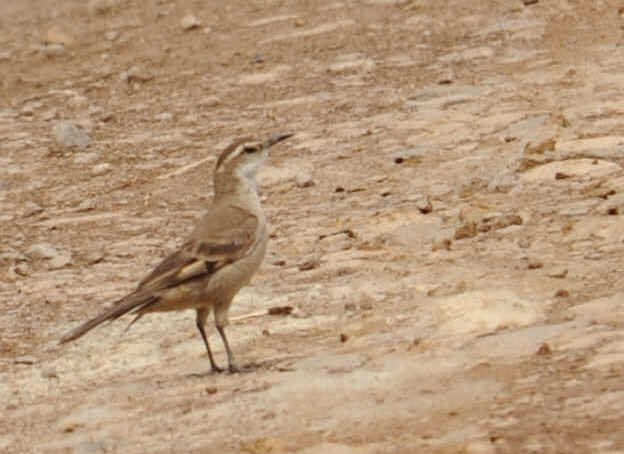
A Long-tailed Cinclodes
photographed during the FONT tour
in Rio Grande do Sul in October 2010
The species is a very localized Brazilian endemic. It was described in
1969.
FURNARIUS
Rufous Hornero
(ph) (*) ______ br ES:oct
IG:aug,sep MN:mar,may,aug,sep,oct MS:mar,aug,sep MT:mar,aug,oct RS:jul,aug,oct
SE:mar,may,jul,aug,oct
Furnarius r. rufus (fs,ig)
Furnarius rufus albogularis (br,es,mn)
Furnarius rufus commersoni (mt)
Outside Brazil, the Rufous Hornero has been found during FONT
tours in Argentina, Bolivia, Paraguay, Uruguay.
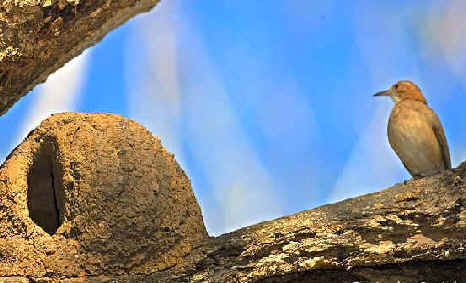
Above: A Rufous Hornero by its nest
Below: A Rufous Hornero photographed during the May 2011
FONT tour in Minas Gerais, Brazil (photo by Patricia Yoder)
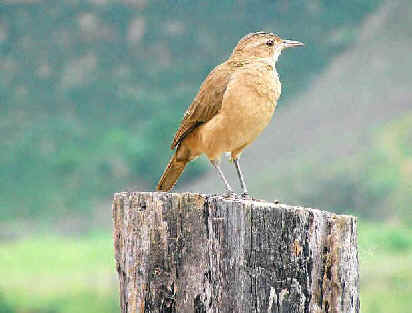
Pale-legged Hornero
(*) ______ AM:aug MS:mar,aug,sep
MT:aug
Furnarius leucopus assimilis
Band-tailed Hornero
(BRe)
(*) ______ MN:may,sep,oct
SE:may,aug,oct (has been called Wing-banded Hornero)
Furnarius f. figulus
Pale-billed
Hornero ______ (in far-western Amazonian Brazil)
Furnarius torridus
Lesser
Hornero ______ (in Amazonian Brazil, near the river)
Furnarius minor
Outside Brazil, the Lesser Hornero has been found during FONT tours in
Ecuador.
LEPTASTHENURA
Araucaria
Tit-Spinetail (nt) (*) ______ RS:jul
SE:jul,oct
Leptasthenura setaria (monotypic)
Striolated
Tit-Spinetail (BRe) (*) _____ RS:oct
Leptasthenura striolata
(monotypic)
Tufted
Tit-Spinetail ______ (in far-southern Brazil)
Leptasthenura platensis
Outside Brazil, the Tufted Tit-Spinetail
has been found during FONT tours in Argentina.
SCHOENIOPHYLAX
Chotoy Spinetail
(*) ______ mt MS:aug RS:oct
Schoeniophylax p. phryganophilus
Outside Brazil, the Chotoy Spinetail has been found during
FONT tours in Argentina.
OREOPHYLAX
Itatiaia Spinetail
(BRe)
(*) ______ SE:aug,oct
Oreophylax
(formerly Schizoeaca) moreirae
(monotypic, and the single member of its genus)
ASTHENES
Cipo Canastero (t2)
(BRe) (*) ______ MN:may,oct
Asthenes luizae (monotypic)
The Cipo Canastero was discovered as recently as 1985.
Regarding the CIPO CANASTERO, go to: RARE
BIRDS of BRAZIL
Hudson's Canastero ______ (in far-southern
Brazil)
Asthenes hudsoni
Short-billed Canastero ______ (in far-southern
Brazil)
Asthenes baeri
Outside Brazil, the Short-billed Canastero has been found during
FONT tours in Argentina.
Sharp-tailed
Canastero ______ (undocumented records in far-southern Brazil)
Asthenes pyrrholeuca
Outside Brazil, the Sharp-tailed Canastero has been found during FONT
tours in Argentina, Chile.
SYNALLAXIS
Rufous-capped Spinetail
(BRqe) (*) ______ br MN:may,sep,oct mt
RS:oct
SE:jul,aug,oct
Synallaxis ruficapilla (monotypic)
White-lored Spinetail
(*) ______ MS:mar,aug,sep MT:aug (was part of the Plain-crowned Spinetail)
Synallaxis albilora simoni
Sooty-fronted
Spinetail (*) ______ MN:may,oct
MT:oct
MS:aug,sep SE:may,aug (includes
"Gray-browed Spinetail")
Synallaxis f. frontalis
Pale-breasted Spinetail
(*) ______br MN:oct MT:aug,oct MS:mar,aug
SE:aug
Synallaxis a. albescens
Outside Brazil, the Pale-breasted Spinetail has been found during FONT tours
in Argentina, Venezuela.
Spix's Spinetail
(*) ______ MN:may,sep,oct RS:oct SE:aug,oct (has also been called Chicli Spinetail)
Synallaxis spixi (monotypic)
Outside Brazil, the Spix's Spinetail has been found during FONT
tours in Argentina, Uruguay.
Gray-bellied Spinetail
(BRqe) (*) ______ MN:sep se
Synallaxis cinerascens (monotypic)
Outside Brazil, the Gray-bellied Spinetail has been found during
FONT tours in Argentina.
Ruddy Spinetail
(*) ______ mt
Synallaxis rutilans tertia
Chestnut-throated Spinetail
(nt) (*) ______ af
Synallaxis c. cherriei
Pinto's
Spinetail (t1) (BRe) ______ (has also been called Plain
Spinetail) (in northeast Brazil)
Synallaxis infuscata
Bahia
Spinetail (t2) (BRe) ______ (in northeast Brazil)
Synallaxis cinerea
Cinereous-breasted
Spinetail ______
Synallaxis hypospodia
Dark-breasted
Spinetail ______ (in western Amazonian Brazil)
Synallaxis albigularis
Outside Brazil, the Dark-breasted Spinetail has been found during FONT tours
in Ecuador.
White-bellied
Spinetail ______ (in western Amazonian Brazil)
Synallaxis propinqua
Outside Brazil, the White-bellied Spinetail has been found during FONT tours
in Ecuador.
McConnell's
Spinetail ______ (in far-northern Brazil)
Synallaxis macconnelli
Hoary-throated
Spinetail (t2) ______ (in far-northern Brazil)
Synallaxis kollari
Cabanis's
Spinetail (nt) ______ (locally in Brazil, in extreme northern Mato
Grosso)
Synallaxis cabanisi
Plain-crowned
Spinetail ______
Synallaxis gujanensis
Ochre-cheeked Spinetail
(*) ______ MT:aug
Synallaxis s. scutatus
Outside Brazil, the Ochre-cheeked Spinetail has been found during
FONT tours in Argentina.
CERTHIAXIS
Yellow-chinned Spinetail
(*) ______ br IG:jul MN:may,aug,sep
MS:mar,aug,sep MT:aug
RS:jul,oct
SE:aug,oct
Certhiaxis cinnamomea russeolus
Outside Brazil, the Yellow-chinned Spinetail has been found during FONT tours
in Bolivia, Venezuela.
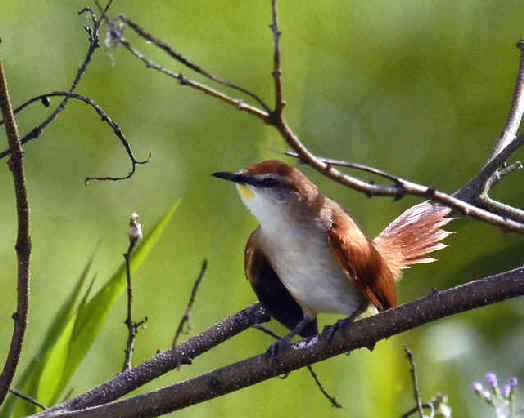
Yellow-chinned Spinetail
(photo by Leroy Tabb)
Red-and-white
Spinetail (*) ______ AM:feb (in Amazonian Brazil, near the river)
Certhiaxis mustelinus
CRANIOLEUCA
Rusty-backed Spinetail
(*) ______ AM:aug MS:mar
MT:aug,oct
Cranioleuca v. vulpina
Olive Spinetail
(*) ______
ig se (closely
related to, once said to be conspecific with, Stripe-crowned
Spinetail of
northern Argentina)
Cranioleuca
obsoleta (monotypic)
Pallid Spinetail
(BRe)
(*) ______ MN:may,oct SE:may,aug,oct (also called "Pale-browed Spinetail")
Cranioleuca pallida
Parker's
Spinetail ______ (in Amazonian Brazil, near the river)
Cranioleuca vulpecula
Sulphur-bearded
Spinetail ______ (has also been called Sulphur-throated
Spinetail) (in far-southern Brazil)
Cranioleuca sulphurifera
Outside Brazil, the Sulphur-bearded Spinetail has been found
during FONT tours in Argentina.
Stripe-crowned
Spinetail ______ (in far-southern Brazil)
Cranioleuca pyrrhophia
Outside Brazil, the Stripe-crowned Spinetail has been found
during FONT tours in Argentina.
Gray-headed
Spinetail (BRe) ______ (in northeast Brazil)
Cranioleuca semicinerea
Tepui
Spinetail ______ (in far-northern Brazil)
Cranioleuca demissa
Speckled
Spinetail ______ (in northern Brazil)
Cranioleuca gutturata
Scaled
Spinetail (t2) (BRe) ______ (in eastern Amazonian Brazil)
Cranioleuca muelleri
THRIPOPHAGA
Plain
Softtail ______
(locally in Amazonian Brazil)
Thripophaga fusciceps
Striated
Softtail (t2) (BRe) ______ (in eastern Brazil)
Thripophaga macroura
PHACELLODOMUS
Rufous-fronted Thornbird
(ph) (*) ______ br MN:may,sep,oct
MS:mar MT:aug
SE:aug
Phacellodomus r. rufifrons (br,mn,se)
Phacellodomus r. sincipitalis
(includes fargoi)
(mt)
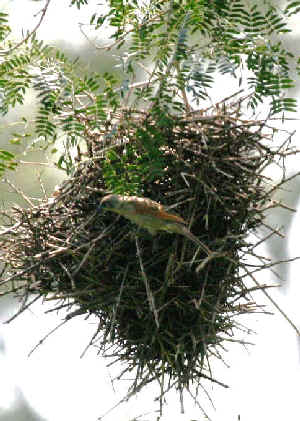
A Rufous-fronted Thornbird at its nest.
Photographed during a FONT Brazil Tour in Mato Grosso do Sul.
Greater Thornbird
(*) ______ MS:mar,aug,sep MT:aug
Phacellodomus ruber
(monotypic)
Outside Brazil, the Greater Thornbird has been found during FONT
tours in Argentina, Bolivia.
Orange-eyed Thornbird
(BRe) (ph) (*) ______ MN:oct se
Phacellodomus erythrophthalmus
(occurs
generally north
of
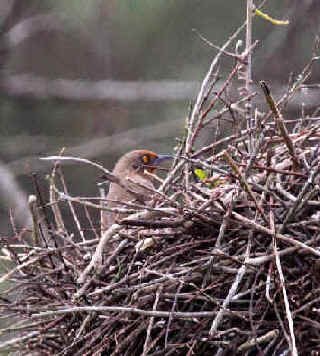
Orange-eyed
Thornbird, at its nest
Photographed during a FONT Brazil Tour
in Minas Gerais in October 2009.
Red-eyed Thornbird
(BRe) (*) ______ se (was
conspecific with the Orange-eyed Thornbird)
Phacellodomus ferrugineigula
Freckle-breasted
Thornbird (*) ______ RS:oct (in far-southern Brazil)
Phacellodomus
striaticollis
Outside Brazil, the Freckle-breasted Thornbird has been found
during FONT tours in Argentina.
CLIBANORNIS
Canebrake Groundcreeper (t3)
(*) _____ RS:oct
Clibanornis dendrocolaptoides (monotypic, and the single member of its
genus)
SPARTONOICA
Bay-capped
Wren-Spinetail (nt) ______ (in far-southern Brazil)
Spartonoica maluroides
Outside Brazil, the Bay-capped Wren-Spinetail has been found during
FONT tours in Argentina.
PHLEOCRYPTES
Wren-like Rushbird
(*) _____ RS:oct
Phleocryptes m. melanops (the single member of its genus)
Outside Brazil, the Wren-like Rushbird has been found during
FONT tours in Argentina, Chile.
LIMNORNIS
Curve-billed
Reedhaunter ______ (in far-southern Brazil)
Limnornis curvirostris
Straight-billed
Reedhaunter (nt) ______ (in far-southern Brazil)
Limnornis rectrostris
ANUMBIUS
Firewood-gatherer
(*) ______ MN:sep,oct MS:oct RS:jul,oct SE:aug
Anumbius annumbi (monotypic, and the single member of its genus)
Outside Brazil, the Firewood-gatherer has been found during FONT
tours in Argentina, Uruguay.
CORYPHISTERA
Lark-like
Brushrunner ______ (in far-southern Brazil)
Coryphistera
alaudina
Outside Brazil, the Lark-like Brushrunner has been found
during FONT tours in Argentina.
METOPOTHRIX
Orange-fronted
Plushcrown ______ (in western Amazonian Brazil)
Metopothrix aurantiaca
Outside Brazil, the Orange-fronted Plushcrown has been found during FONT
tours in Ecuador.
RORAIMIA
Roraiman
Barbtail ______ (in far-northern Brazil)
Roraimia adusta
ACROBATORNIS
Pink-legged
Graveteiro (t3) (BRe) ______
(in eastern Brazil)
Acrobatornis fonsecai
PSEUDOSEISURA
Gray-crested Cachalote
(*) ______ MS:mar,aug,sep mt (was called
Rufous Cachalote)
Pseudoseisura unirufa (monotypic)
(When
it was Rufous
Cachalote, the
scientific name was Pseudoseisura
cristata. That
scientific name now applied to the newly-split Caatinga
Cachalote of
eastern Brazil south to Minas Gerais, and a few other areas of Brazil &
Bolivia)
Caatinga
Cachalote (BRe) ______
Pseudoseisura
cristata
Brown Cachalote ______ (in far-southern Brazil)
Pseudoseisura lophotes
Outside Brazil, the Brown Cachalote has been found during FONT
tours in Argentina.
SIMOXENOPS
Peruvian
Recurvebill (nt) ______ (locally in southern Amazonian Brazil)
Simoxenops ucayalae
ANCISTROPS
Chestnut-winged
Hookbill ______ (in western Amazonian Brazil)
Ancistrops strigilatus
HYLOCTISTES
Eastern
Striped
Woodhaunter ______ (in southern Amazonian Brazil, south of the river)
Hyloctistes subulatus
BERLEPSCHIA
Point-tailed Palmcreeper (*) ______
MT:aug,oct
Berlepschia rikeri (monotypic)
Outside Brazil, the Point-tailed Palmcreeper has been found during FONT tours
in Ecuador.
GYALOPHYLAX
Red-shouldered
Spinetail (BRe) ______ (in northeast Brazil)
Gyalophylax hellmayri (the single member of its genus)
ANABACERTHIA
White-browed Foliage-gleaner
(nt) (BRqe) (*) ______ MN:may,oct SE:aug,oct
Anabacerthia amaurotis (monotypic)
SYNDACTYLA
Buff-browed Foliage-gleaner
(*) ______ mn SE:aug,oct
Syndactyla r. rufosuperciliata
ANABAZENOPS
White-collared Foliage-gleaner
(BRe)
(*) ______ ES:oct mn SE:aug,oct
Anabazenops fuscus (monotypic)
Dusky-cheeked
Foliage-gleaner
______ (also called Bamboo Foliage-gleaner)
(locally in southern Amazonian Brazil)
Anabazenops dorsalis
PHILYDOR
Black-capped Foliage-gleaner
(*) ______ IG:jul MN:may,oct
SE:may,aug,oct
Philydor atricapillus
(monotypic)
Outside Brazil, the Black-capped Foliage-gleaner has been found
during FONT tours in Argentina.
Planalto
Foliage-gleaner (nt) (BRqe) (*) ______ MT:mar
(was
called Russet-mantled Foliage-gleaner)
Philydor d. dimidiatus
Buff-fronted
Foliage-gleaner (*) ______ MN:may,sep mt
SE:aug,oct
Philydor rufum chapadense (mt)
Philydor r. rufum (mn,se)
Outside Brazil, the Buff-fronted Foliage-gleaner has been
found during FONT tours in Argentina.
Rufous-tailed Foliage-gleaner
(*) ______ AF:oct
Philydor r. ruficaudatum
Ochre-breasted Foliage-gleaner
(BRqe) (*) ______ IG:jul,aug,sep mn SE:oct
Philydor lichtensteini
(monotypic)
Outside Brazil, the Ochre-breasted Foliage-gleaner has been found
during FONT tours in Argentina.
Rufous-rumped Foliage-gleaner
(*) ______ AM:aug
Philydor erythrocercum lyra
Chestnut-winged Foliage-gleaner
(*) ______ AF:oct
Philydor e. erythropterus
Philydor novaesi
Cinnamon-rumped
Foliage-gleaner ______ (in northern Brazil)
Philydor pyrrhodes
AUTOMOLUS
Para
Foliage-gleaner
(or Automolus) (*) (BRe) ______ af
(was part of Olive-backed Foliage-gleaner, Automolus
infuscatus)
Automolus paraensis
Chestnut-crowned Foliage-gleaner
(or Automolus) (*) ______ af
Automolus r. rufipileatus
Outside Brazil, the Chestnut-crowned Foliage-gleaner has been found during
FONT tours in Ecuador.
Buff-throated Foliage-gleaner
(or Automolus) (*) ______
mt
Automolus ochrolaemus auricularis
White-eyed Foliage-gleaner
(or Automolus) (BRqe) (*) ______
IG:jul MN:may se
Automolus leucophthalmus sulphurascens
Outside Brazil, the White-eyed Foliage-gleaner has been found
during FONT tours in Argentina.
Olive-backed
Foliage-gleaner
(or Automolus) ______
Automolus infuscatus
Brown-rumped
Foliage-gleaner (or Automolus) ______ (in southwestern Amazonian
Brazil)
Automolus melanopezus
White-throated
Foliage-gleaner (or Automolus) ______ (also
called Tepui Foliage-gleaner) (in far-northern Brazil)
Automolus roraimae
Ruddy
Foliage-gleaner
(or Automolus) ______
Automolus rubiginosus
HYLOCRYPTUS
Henna-capped Foliage-gleaner (nt)
(BRqe) (*) ______ mn (also called
Chestnut-capped Foliage-gleaner)
Hylocryptus rectirostris (monotypic)
CICHLOCOLAPTES
Pale-browed Treehunter
(BRe)
(*) ______ SE:aug,oct
Cichlocolaptes leucophrus (monotypic,
and the single member of its genus)
Cryptic
Treehunter (t1) (BRe) ______ (species described
in November 2014)
Cichlocolaptes mazarbarnetti
A bird of northeastern Brazil, the Cryptic Treehunter was
described from a specimen that was for many years confused with another
species, the Alagoas Foliage-gleaner, Philydor
novaesi.
Cichlocolaptes mazarbarnetti is
known from only 2 sites, 1 in the state of Alagoas, and 1 in the state of
Pernambuco.
HELIOBLETUS
Sharp-billed Treehunter
(BRqe) (*) ______ SE:jul,aug,oct
Heliobletus c. contaminatus
XENOPS
Plain Xenops
(ph)
(*) ______ af IG:jul MN:may MT:mar,aug SE:aug,oct
Xenops m. minutus (ig,se,mn)
("Minute Xenops")
Xenops m. genibarbis (af,mt)
Outside Brazil, the Plain Xenops has been found during FONT tours in
Belize, Venezuela.
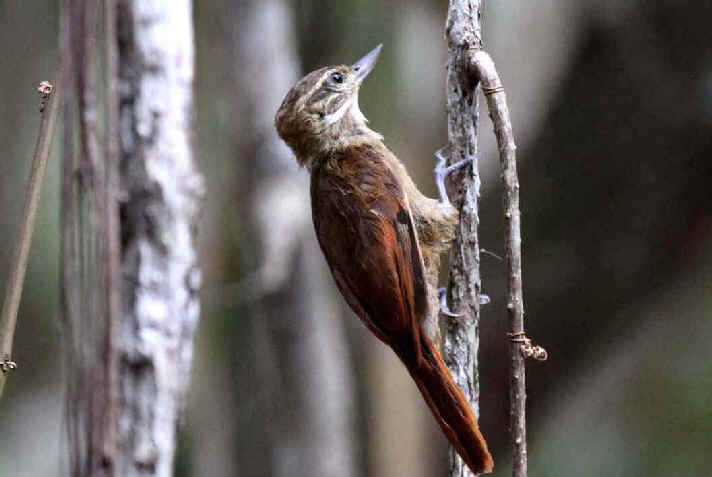
A Plain Xenops photographed during a
FONT tour
(photo by Marie Gardner)
Streaked Xenops
(*) ______ af br es MN:may,oct MS:sep
MT:oct
SE:aug,oct
Xenops r. rutilans
(br,mn,se)
Xenops rutilans purusianus (af)
Xenops rutilans genibarbis (mt)
Rufous-tailed Xenops
(*) ______ AF:oct
Xenops milleri
(monotypic)
Slender-billed
Xenops ______
Xenops tenuirostris
MEGAXENOPS
Great
Xenops (nt) (BRe) ______ (in northeast Brazil)
Megaxenops parnaguae
SCLERURUS
Rufous-breasted Leaftosser
(BRqe) (*) ______ se
Sclerurus s. scansor
Tawny-throated
Leaftosser ______
Sclerurus mexicanus
Short-billed
Leaftosser ______
Scierurus rufigularis
Black-tailed
Leaftossser ______
Scierurus caudacutus
Outside Brazil, the Black-tailed Leaftosser has been found during FONT tours
in Ecuador,
Gray-throated
Leaftosser (nt) ______
Scierurus albigularis
LOCHMIAS
Sharp-tailed
Streamcreeper (BRqe) (*) ______ MN:sep,oct
MT:oct SE:jul,aug,oct (has also been
called Streamside Lochmias)
Lochmias n. nematura
CAMPYLORHAMPHUS
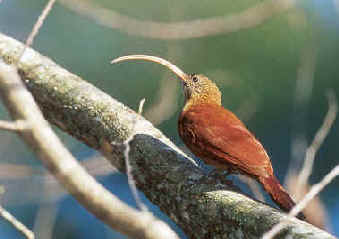
Buff-throated Woodcreeper
(includes
Dusky-billed Woodcreeper (BRe) )
(*) ______ AF:oct AM:feb,aug
MT:aug,oct
Xiphorhyncus guttaus eytoni (af,am)
Xiphorhyncus guttaus dorbignyanus (mt)
Straight-billed Woodcreeper
(*) ______ af AM:aug MT:aug
Xiphorhyncus picus rufescens
Zimmer's Woodcreeper
(nt)
(*) ______ AM:aug
Dendroplex (formerly Xiphorhyncus) necopinus
(monotypic)
Elegant Woodcreeper
(formerly part of what was an expanded Spix's Woodcreeper,
Xiphorhyncus
spixii) (*) ______ AF:oct mt
Xiphorhyncus e. elegans
Spix's
Woodcreeper ______
Xiphorhyncus spixii
Lesser Woodcreeper
(BRqe) (*) ______ IG:jul MN:sep SE:aug,oct
Xiphorhyncus
(formerly
Lepidocolaptes) f.
fuscus
Ocellated Woodcreeper (*) ______ AM:feb
(in Amazonian Brazil)
Xiphorhyncus ocellatus
Outside Brazil, the Ocellated Woodcreeper has been found during FONT tours
in Ecuador.
Chestnut-rumped Woodcreeper ______ (in Brazil, north of the Amazon)
Xiphorhyncus pardalotus
Striped
Woodcreeper ______
Xiphorhyncus obsoletus
Outside Brazil, the Striped Woodcreeper has been found during FONT tours in
Ecuador, Venezuela.
LEPIDOCOLAPTES
Lineated Woodcreeper
(*) ______ AF:oct MT:aug,oct
Lepidocolaptes albolineatus (2
subspecies in central
Scaled Woodcreeper
(BRe)
(*) ______ ES:oct MN:may,sep,oct SE:may,aug,oct
Lepidocolaptes s. squamatus
Scalloped Woodcreeper
(BRqe) (*) ______ RS:jul,oct SE:aug
(has been part of Scaled
Woodcreeper)
Lepidocolaptes falcinellus (monotypic)
Outside Brazil, the Scalloped Woodcreeper has been found during
FONT tours in Argentina.
Narrow-billed Woodcreeper
(ph) (*) ______ ig MN:mar,sep,oct
MS:mar,aug,sep MT:mar,aug se
Lepidocolaptes a. angustirostris (ig,mt,se)
Lepidocolaptes angustirostris bivittatus (mn)
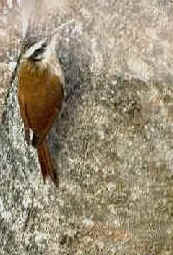
Narrow-billed Woodcreeper
Streak-headed
Woodcreeper ______ (in far-northern Brazil)
Lepidocolaptes souleyetii
Outside Brazil, the Streak-headed Woodcreeper has been found during
FONT tours in Venezuela.
DRYMORNIS
Scimitar-billed
Woodcreeper ______ (in far-southern Brazil)
Drymornis bridgesii
Outside Brazil, the Scimitar-billed Woodcreeper has been found during
FONT tours in Argentina.
![]()
Places visited during FONT Brazil
tours have included:
In the southern portion of Mato Grosso state, the areas of: the Pantanal, Chapada dos Guimaraes, Serra das Araras.
In the central portion of Mato Grosso state, the Jardim da Amazonia by the Rio Claro.
In northern Mato Grosso state, Amazonian Rainforest in the areas of Alta Floresta and the Rio Cristalino.
In southeastern Brazil, the Atlantic Rainforest in the areas of Itatiaia, Serra do Mar, Intervales, Campos do Jordao, Ubatuba, Angra dos Reis, and Nova Friburgo in the states of Rio de Janeiro and Sao Paulo. Also, in the vicinity of the city of Rio de Janeiro, including the Tijuca Forest. Along the coast near Sao Paulo, Cubatao.
In the state of Minas Gerais, FONT birding tours have been to: Serra do Cipo, Serra da Canastra, Rio Doce, Caraca and Caparao. Also, an adjacent area in the state of Espiritu Santu (where the ultra-rare Cherry-throated Tanager has been seen).
Other locations where
FONT has been in Brazil include Iguacu Falls (with fine forest in
the national park) and Brasilia (with good cerrado habitat).